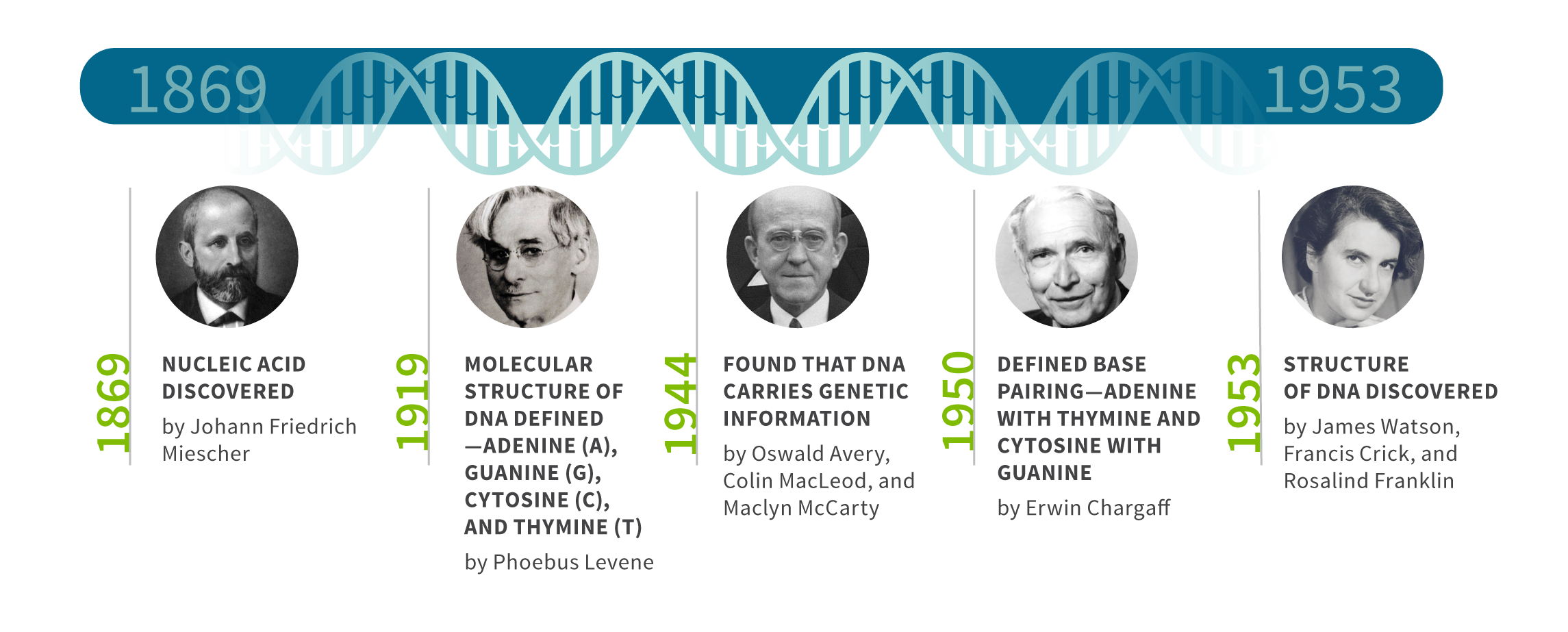Who Discovered DNA?
When Was DNA Discovered?
There is no single discovery date for DNA, but 1953 is the date when DNA’s famous double helix structure was finally discovered. Many research findings between 1869 and 1953—about different aspects of DNA’s nature—contributed to the important discovery about DNA’s structure. Even today, scientists continue to explore and learn about how DNA’s contents and structure impact its overall function.
Who Discovered DNA?
No one person discovered DNA. Instead, as different scientists began to uncover more and more about DNA, starting in 1869, their accumulated findings paved the way to the discovery of the double helix structure. Here are some of the key contributors to DNA’s discovery.

- Johann Friedrich Miescher’s Discovery of Nuclein: It all started humbly enough in 1869, when Swiss chemist Miescher found a phosphorus-containing substance in white blood cells unlike the proteins he expected to find. He called this substance a nuclein. Later, it became known as nucleic acid.
- Phoebus Levene’s Role in DNA’s Discovery: Fifty years later, in 1919, Russian-born biochemist Levene characterized nucleic acids as molecules made of phosphate, sugar, and four nitrogenous bases—adenine (A), guanine (G), cytosine (C), and thymine (T). Levene also differentiated the deoxyribonucleic acid (DNA) from the related genetic material ribonucleic acid (RNA).
- Oswald Avery, Colin MacLeod, and Maclyn McCarty Uncover DNA’s Genetic Role: By 1944, Avery, MacLeod, and McCarty, at the Rockefeller Institute in New York, showed that DNA—not proteins, as others had previously assumed—was the substance that passed along genetic information in experiments involving bacterial transformation.
- Rosalind Franklin, Maurice Wilkins, and Raymond Gosling on X-ray Diffraction: Studies of DNA's structure through X-ray diffraction, by Maurice Wilkins and Raymond Gosling, began in 1946. Rosalind Franklin’s expertise was then brought to the team, where she contributed pivotal images of crystallized DNA and crystallographic calculations. These images were critical to solving the mystery of DNA's double helix structure.
- Erwin Chargaff and DNA’s Chemical Rules: In 1950, Chargaff published a paper outlining the chemical rules for how nucleotide bases pair—that adenine always pairs with thymine, and cytosine pairs with guanine. These paired bases are part of the DNA structure.
- James Watson, Francis Crick, and DNA’s Double Helix Structure: Watson and Crick's quest to discover the structure of DNA began with their first meeting in the summer of 1951. The model they initially proposed was wrong, featuring three strands of DNA instead of two. The turning point came when they gained access to Rosalind Franklin's work.
In 1953, Watson and Crick published their findings on the structure of DNA in a paper titled “A Structure for Deoxyribose Nucleic Acid.” Accompanying Watson and Crick’s paper in the journal Nature were two additional articles on DNA’s structure: one by Maurice Wilkins and one by Rosalind Franklin and her colleague Raymond Gosling. Together, their findings fundamentally changed how scientists (and eventually everyone) thought about how the DNA molecule worked in heredity.
The Nobel Prize
While the breakthrough discovery of DNA’s famous double helix structure is often credited to Watson and Crick, they relied extensively on the important DNA research conducted by many others over many years.
In 1962, Watson and Crick were awarded the Nobel Prize, together with Maurice Wilkins, for the discovery of DNA's structure. Rosalind Franklin, who had died four years before, was not included in the Nobel Prize, as a Nobel Prize can only be shared by three living scientists.
The Significance of the Discovery of DNA's Structure
The DNA double helix is the most well-known molecular structure in all of biology. It gave an explanation for how DNA is replicated when a cell divides, how it is inherited from generation to generation, and how such an elementary molecule could provide all the incredible complexity displayed by life on Earth.
The discovery of DNA and its structure is considered one of the most important scientific discoveries in modern times, leading to the development of modern molecular biology and genomics.
References
Franklin, Rosalind and Raymond Gosling. “Molecular Configuration in Sodium Thymonucleate.” Nature. April 25, 1953. https://doi.org/10.1038/171740a0.
Watson, James and Francis Crick. “Molecular Structure of Nucleic Acids: A Structure for Deoxyribose Nucleic Acid.” Nature. April 25, 1953. https://doi.org/10.1038/171737a0.
Wilkins, Maurice H.F., Stokes, Alexander R., and Wilson, Herbert R. “Molecular Structure of Nucleic Acids: Molecular Structure of Deoxypentose Nucleic Acids.” Nature. April 25, 1953. https://doi.org/10.1038/171738a0.